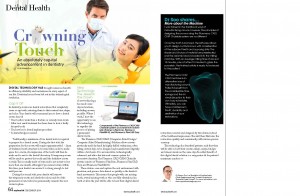 This article first appeared in the December 2014 issue of Ezyhealth magazine. We have reproduced it for the information of those of you who missed it when it was published.
This article first appeared in the December 2014 issue of Ezyhealth magazine. We have reproduced it for the information of those of you who missed it when it was published.
Digital technology has brought numerous benefits in efficiency, reliability and convenience in every aspect of our life and dentistry has not been left out in this technological revolution.
Cap It Off
In dentistry, crowns are dental restorations that completely cover or cap teeth, restoring them to their natural size, shape, and color. Your dentist will recommend you to have a dental crown done if:
- Your tooth is weak from a fracture or severely worn down
- After root canal treatment has been done to treat a badly decayed tooth
- You have had a dental implant procedure
- A dental bridge is needed
Traditionally, a minimum of two dental visits is required to prepare for a dental crown. During the first visit, the preparation for the crown will require approximately 1 – 2mm of weakened tooth structure to be removed in order to make space for a crown. An impression of the tooth will then be made and is sent to the dental laboratory. A temporary crown will be made to protect the tooth until the definitive crown is ready. This is usually made of resin and is not meant to last more than one month, although if you cannot return within this time, your dentist can ensure it is strong enough to last until you can.
During the second visit, your dentist will remove the temporary crown and check the colour and fit of the permanent crown, before he permanently cements the new crown in place.
New Technology: The Jewel in The Crown
A new technology today has made same-day restorations, including crowns possible. Where I work, I have the opportunity to use this technology to expedite the process of placing a permanent dental crown.
The Planmeca CAD/CAM (Computer Aided Design/ Computer Aided Manufacturing) Solution allows crowns previously made by hand by highly skilled technicians, often taking several days, to be designed and manufactured digitally within a few hours. It is an innovative, technologically advanced, and ultra-fast intraoral scanner system for restorative dentistry. Plameca CAD/CAM Chairside consists of Planmeca PlanScan, Planmeca PlanCAD Easy and Planmeca PlanMill 40.
These devices scan and capture the oral environment with precision, and processes data almost as quickly as the dentists’ hand movements. This means that people with one missing tooth, several missing teeth or are fully edentulous (totally no teeth at all in the jaw) will be able to have their digital dental restorations created and designed by this device, instead of the traditional impressions. The mill then fabricates the restoration designs quickly and conveniently, with micron-precise accuracy.
This technology has benefited patients such that they will be able to have their crowns, inlays, onlays, bridges and veneers made on the same day. An added benefit of this digital dental solution is the prostheses’ precise fit for patients’ maximum comfort.
Dr Soo Shares More about the Machine
 I was trained in the traditional ways of manufacturing crowns; however, the principles of designing the crowns using the Planmeca CAD/CAM Chairside system are no different.
I was trained in the traditional ways of manufacturing crowns; however, the principles of designing the crowns using the Planmeca CAD/CAM Chairside system are no different.
Once the tooth is scanned, the software allows you to design a virtual crown with consideration of the adjacent teeth and opposing bite. The shade and choice of material are preselected and the ceramic block is loaded into the milling machine. With an average milling time of around 15 mins, plus a further 15 mins to glaze the porcelain, the finished article is ready to be issued to the patient.
The Planmeca CAD/CAM machine is an alternative way of manufacturing crowns. Patients benefit from the considerable time savings and the minimal disruption to their own busy schedules. Ultimately, you can have confidence in the fit, durability and aesthetics of your restorations.





